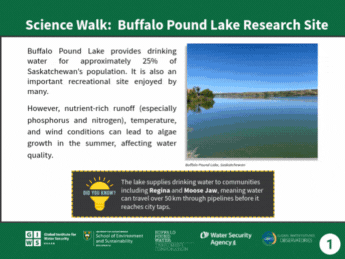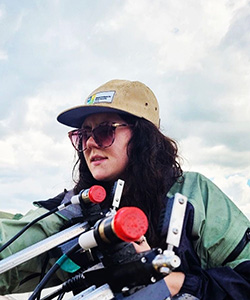Buffalo Pound Lake
Buffalo Pound Lake is the drinking water source for approximately 25% of Saskatchewan’s population, including the cities of Moose Jaw, Regina and surrounding areas. It is also an important recreational site enjoyed by many. The lake acts like a reservoir, with inflows from Lake Diefenbaker and outflows to the Qu'Appelle River being controlled by dams.
The lake is nutrient-rich, which promotes the growth of algae and cyanobacteria, and is relatively high in dissolved organic matter. In the summer, the lake often undergoes rapid changes in cyanobacterial bloom dynamics which can create challenges for water treatment and concerns for recreational users. A long-term partnership between the University of Saskatchewan and the Buffalo Pound Water Treatment Plant (BPWTP) has supported real-time water quality monitoring of Buffalo Pound Lake for more than a decade to provide early warnings of challenging water quality conditions and advance the understanding of factors affecting bloom dynamics in a shallow prairie lake.
Water Quality Monitoring Buoys
Since 2014, researchers have deployed water quality monitoring buoys on Buffalo Pound Lake that are equipped with sensors to gather data in real-time. This data provides important information to researchers and water treatment operators so they can understand and assess changing lake conditions as they happen. These early warnings of challenging water quality conditions allow the BPWTP to adapt its processes in real time to live conditions, and researchers use the data to help understand the effects of extreme wind or calm hot weather on lake conditions as they happen.
Real-time data from four water quality monitoring buoys are freely accessible online.
View Real-Time Water Quality Data
Note about real-time data: This data is available seasonally when the monitoring buoys are deployed. When the buoys are not active, this data stream is unavailable. There may be periods when some sensors may be offline. All data is subject to quality control following the deployment season.
Historically, researchers have relied upon weekly or monthly measurements. Sensor technology allows us to measure changes in lakes much more frequently, and with this new technology we are learning just how rapidly lakes can change, informing science, lake management, and water treatment. Our buoy systems have expanded from a single system to multiple buoys. These are used to understand differences in lake conditions near two water treatment intakes (and provide redundancy for water treatment operators), and understand how water quality changes as water transits through the lake.
Currently, four buoys are deployed on Buffalo Pound Lake, providing multiple insights related to chemistry, algae and water treatability.
Meet the Buoys
Location on lake: Big Buoy is located near the water intake pipes for the BPWTP (nearshore site).
Big is our longest-serving buoy, providing useful data for water treatment operators, and contributing to our understanding of how water quality varies over time.
Super Buoy is located near the water intake pipes for the BPTWP (mid-lake site).
Super Buoy is our most advanced buoy, located at the site where we have the most extensive monitoring record. Like Big Buoy, it is located near a water treatment intake, hence provides important real time data for operators. Combined with insights from Big Buoy, we can understand how water quality differs in shallow vs deeper areas (and across the two drinking water intakes). It also is critical in understanding long-term drivers of water quality change in the lake associated with changes in climate and other factors.
Della is located southeast of the highway 2 causeway in the northern end of the lake.
Sandy is located near the village of South Lake (mid-lake), about 3.7 km south of Della.
Della and Sandy, the Twins, were deployed in 2025 to help us understand how lake water quality varies as water moves through the lake system. Della, Sandy, and Super Buoy also provide real time photographs to capture visible changes to the lake environment at the surface and identify key periods to sample (e.g. during scum-forming blooms).
Research and Impact
Research partnerships between researchers at the University of Saskatchewan and our colleagues at the water treatment plant, as well as continued government support, help us to continue this work to understand how the surrounding watershed, management practices, and climate impacts affect the lake ecosystem.
Selected Publications
Baron, A. A. P., Baulch, H. M., Nazemi, A., & Whitfield, C. J. (2025). Novel statistical analysis illustrates the importance of flow source for extreme variation in dissolved organic carbon in a eutrophic reservoir in the Great Plains. Hydrology and Earth System Sciences, 29(5), 1449–1468. https://doi.org/10.5194/hess-29-1449-2025
Gushulak, C. A. C., Chegoonian, A. M., Wolfe, J., Gray, K., Mezzini, S., Wissel, B., Hann, B., Baulch, H., & Leavitt, P. R. (2024, Jun 9). Impacts of hydrologic management on the eutrophication of shallow lakes in an intensive agricultural landscape (Saskatchewan, Canada). Freshwater Biology, 69, 984–1000. https://doi.org/10.1111/fwb.14260
Glines, M. R., Renata, C. H., Amancio, M., Andersen, R., Baulch, H., Brighenti, L. S., Chmiel, H. E., Cohen, J. E., de Eyto, E., Erina, O., Feuchtmayr, H., Flaim, G., Giudici, A., Hamilton, D. P., Huot, Y., Kelly, M. R., Kelly, S., Laas, A., McBride, C., Minaudo, C., Bezerra Neto, J. F., Nugent, K., Ordóñez, C., Perga, M., Reid, B., Scott, C., Staehr, P. A. U., Tonetta, D., Wain, D., Ward, N. K., & Rose, K. C. (2024). Coefficients in Taylor’s Law increase with the time scale of water clarity measurements in a global suite of lakes. Ecology Letters, 27(12), e14451. https://doi.org/10.1111/ele.14451
Painter, K., Venkiteswaran, J. J., & Baulch, H. (2023). Blooms and flows: Effects of variable hydrology and management on reservoir water quality. Ecosphere, 14(3), e4472. https://doi.org/10.1002/ecs2.4472
Painter, K. J., Venkiteswaran, J. J., Simon, D. F., Duy, S. V., Sauvé, S., & Baulch, H. M. (2022). Early and late cyanobacterial bloomers in a shallow, eutrophic lake. Environmental Science: Processes & Impacts, 24(8), 1212–1227. https://doi.org/10.1039/D2EM00078D
Cavaliere, E., & Baulch, H. M. (2020). Winter in two phases: Long-term study of a shallow reservoir in winter. Limnology and Oceanography, 66(4), 1335–1352. https://doi.org/10.1002/lno.11687
Williams, C. J., Conrad, D., Kothawala, D. N., & Baulch, H. M. (2019). Selective removal of dissolved organic matter affects the production and speciation of disinfection byproducts. The Science of the Total Environment, 652, 75–84. https://doi.org/10.1016/j.scitotenv.2018.10.184
Terry, J. A., Sadeghian, A., Baulch, H. M., Chapra, S. C., & Lindenschmidt, K.-E. (2018). Challenges of modelling water quality in a shallow prairie lake with seasonal ice cover. Ecological Modelling, 384, 43–52. https://doi.org/10.1016/j.ecolmodel.2018.06.002
Kehoe, M. J., Chun, K. P., & Baulch, H. M. (2015). Who smells? Forecasting taste and odor in a drinking water reservoir. Environmental Science & Technology, 49(18), 10984–92. https://doi.org/10.1021/acs.est.5b00979
Buffalo Pound Lake Science Walk
 A new Science Walk highlights the research happening at Buffalo Pound Lake! You can explore the signs near the boat launch in Buffalo Pound Provincial Park and at Sandy Beach to learn more about the buoys and how they are helping researchers and the Buffalo Pound Water Treatment Corporation understand the lake environment.
A new Science Walk highlights the research happening at Buffalo Pound Lake! You can explore the signs near the boat launch in Buffalo Pound Provincial Park and at Sandy Beach to learn more about the buoys and how they are helping researchers and the Buffalo Pound Water Treatment Corporation understand the lake environment.



